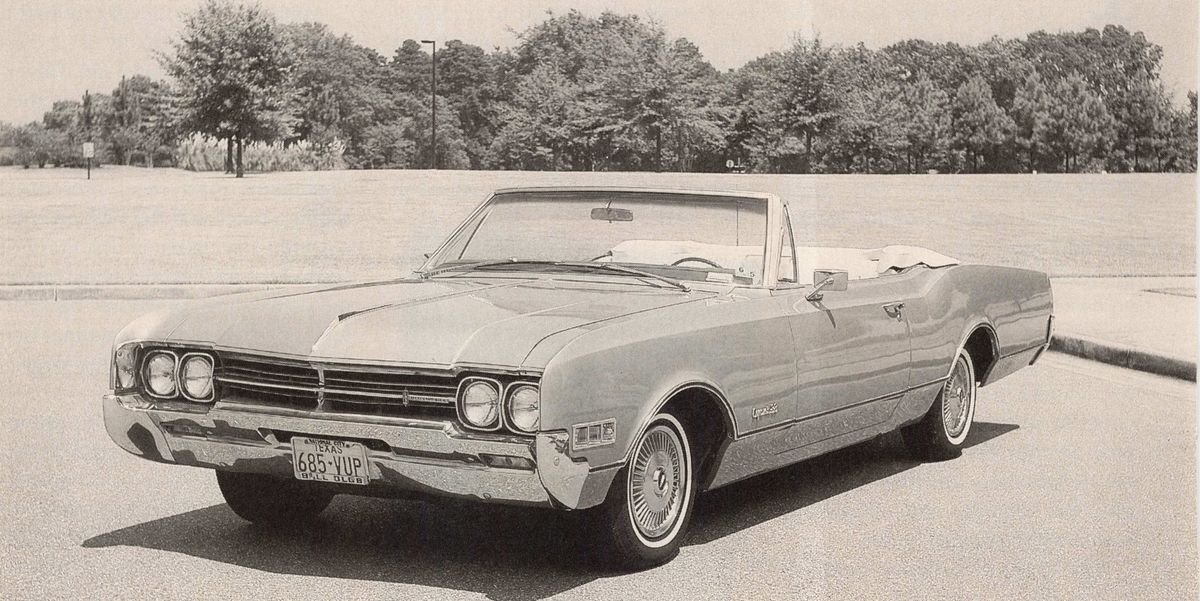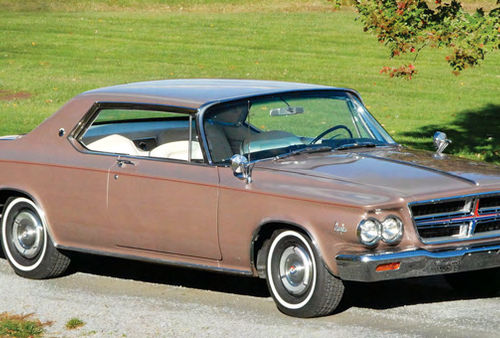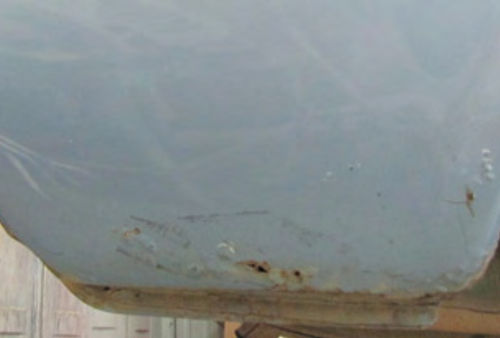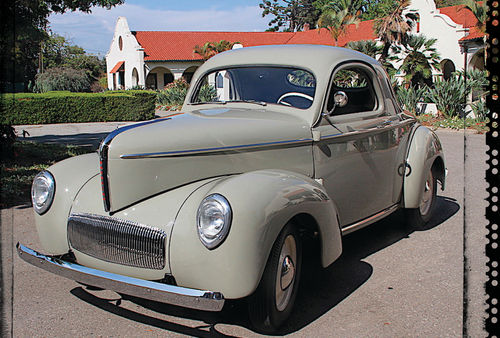1966 Oldsmobile 88
When the Olds 88 first rocketed into dealer showrooms in 1949, it immediately served notice that this would be the wild child in the Oldsmobile lineup. At that time it was a smaller, lighter car that benefited immensely from the modern overhead valve V-8 engine that few other manufacturers could match. It was a hot performance-package that deserved the nickname “Rocket 88.”

By the time the 1966 Olds 88 was introduced to the public, the boisterous car that built its reputation on its appeal to a youthful audience had gracefully edged into the comforts of middle-aged serenity. Most remarkable among the changes was an additional 15 inches of length that stretched the 88 to the size of a 1957 Cadillac Sedan deVille. This was not accomplished without adding a few pounds along the way. In the pages of Motor Trend magazine the 1966 Oldsmobile was described as “a solid citiZen 3.. Stable, Quiet; predictable” Who would have ever thought, back in 1949, that such an evolution would take place?
Oldsmobile basked in the warmth of a 45.3 percent sales gain during 1949; but then almost every auto dealer in the country was selling cars like there was no tomorrow. Car sales were going through the roof. Oldsmobile would have its ups and downs during the succeeding seasons, bouncing as high as fourth place during 1954, then dropping to seventh by 1960. During 1966, the year our featured convertible was built, Olds was comfortably in fifth place, just ahead of intra-corporate rival Buick. With the year’s production totaling 594,069 cars, the division confidently added more than 400,000 square feet of manufacturing space to its Lansing, Michigan, complex.

By this time the Oldsmobile line B had been expanded considerably. There were 11 series ranging from the mid-sized F-85, priced just a tad below Chevrolet’s bare-bones Biscayne, to the revolutionary Toronado, the first front-wheel-drive production car built in this country since the 1937 demise of the fabled Cord. The primary reason that Oldsmobile was in the news in ’66 was unquestionably the Toronado. Its introduction ranked with blockbuster Oldsmobile innovations such as the Hydra-Matic transmission in 1940 and the Rocket V-8 in 1949.
The intermediate-size F-85, Cutlass and 4-4-2 models had a wheelbase of 115 inches, three inches longer than the compact Oldsmobiles of 1961-63. Power for the F-85 came from either a Chevrolet-derived, 155-horsepower in-line six (replacing 1965’s Buick-built V-6), or the familiar 250-horsepower, 330cid Oldsmobile-built V-8, the latter being standard issue for the Cutlass models. A full line of body types was Offered, including pillared coupes, sedans, two- and four-door hardtops, convertibles and station wagons. Fulfilling the desires of the performance-oriented buyers was the task of the 4-4-2 sub-series, musclecars whose standard 400-cubic-inch V-8 engine claimed 350 horsepower (10 more, with the optional tri-carb setup).
Among the full-sized Oldsmobiles, the least expensive was the Jetstar 88, a three-model series including a pillared Celebrity Sedan, as well as two- and four-door Holiday hardtops. Employing the 123 inch wheelbase of the more costly Dynamic 88 and Delta 88 models, these cars were obviously “built to a price.” Their 330 cid V-8 engine and their smaller 9%-inch drum brakes were borrowed from the smaller F85 series.
Priced about $85 higher than the Jetstar 88 was Oldsmobile’s best-selling series, the Dynamic 88. The models consisted of the same three body types as the Jetstar series, with one major addition: a handsome convertible. Standard power for these cars came from a 310-horsepower edition of the division’s 425cid V-8, fitted with 10.25:1 heads. For those who wanted an extra measure of performance, a 305-horsepower version cost only $37 more. Or, for economy-minded buyers there was a 300-horsepower unit, a no-cost option with 9.00:1 compression ratio that permitted the use of regular, rather than high-test fuel. The Delta 88 was a dressed-up version of the Dynamic line. The same four body types were offered; and in addition to substantially upgraded trim, inside and out, the Delta 88s were equipped with amenities such as a foam-padded front-seat cushion and a deluxe steering wheel. Prices were about $184 higher than the Dynamic models.
Available only as a two-door hardtop was the stylish Oldsmobile Starfire, a personal luxury model, developed as a competitor for Ford’s popular Thunderbird. Distinguishing the Starfire were such splashy touches as chrome moldings, special wheel covers (which, in combination, struck some people as a bit gaudy), bucket seats, and a more fashionable interior that included a console. Powering the Starfire was a powerful 455-cid engine, whose 10.50:1 compression ratio was the highest of any Olds powerplant at that time. Horsepower was advertised at 375.

Flagship of Oldsmobile’s conventional, rear-drive offerings was the big, luxurious 98. The line consisted of two-and four-door hardtops, a convertible, and a pair of pillared four-door sedans known, respectively, as the Town Sedan and the Luxury Sedan. Among the items listed as standard equipment on the Luxury Sedan was the Turbo Hydra-Matic transmission, power steering and brakes, power windows and seat and an electric clock. The Luxury Sedan, premium-priced at $4308 or $97 more than Buick’s top-of-the-line Electra 22, ran a close second in popularity among Oldsmobile’s full-sized models, just 619 units behind the Dynamic 88 Celebrity Sedan. 1966 Oldsmobile Dynamic 88
GENERAL
Front engine, rear-wheel-drive convertible
Base price $3381 ENGINE
Type Ohv V-8 Bore x stroke 4.125 in. x 3.975 in. Displacement 425 Cu. in. Compression ratio 10.25:1
Carburetor One Rochester two-barrel Power 310 bhp at 4400 rom Torque 450 Ib.-ft. at 2400 rpm DRIVETRAIN Transmission 3-speed automatic Gear ratios (:1) Trans. Overall Ist 2.48 Rer 2nd 1.48 4 34 3rd 1.00 2.93 Final drive ratio (:1) 2.93
SUSPENSION & BRAKES
Front Independent, coil springs Rear Live axle, coil springs Brakes (f/r) Drum/drum, power assist STEERING
Ratio etd Turns lock-to-lock aw Turning circle 43.66 ft MEASUREMENTS
Wheelbase 123 in. Length 217.9 in Width 80 in. Height 99.9 iN Ground clearance 5 in. Tread (f/r) 62.5/63.0 in. Weight 3967 Ib. Trunk capacity 19.4 cu. ft. Fuel tank capacity 25 gal. Tire size 8.25x14 in. CALCULATED DATA
Weight per bhp 12.8 Ib. Engine revs per mile 4400 Piston travel 2916 ft./mile PERFORMANCE 4 0-30 mph 3.9 SEC. 0-60 mph 10.5 SEC. 0-75 mph _ 15.6 sec. Top speed 109 mph at 4000 rpm Quarter mile — 17.5 sec. at 79 mph
In reviewing a 1966 Olds Dynamic 88 Holiday Sedan, Motor Trend questioned the accuracy of calling this car “Dynamic.” Likewise it regarded as overstatement the “Rocket” designation of its 310 horsepower engine. Nevertheless, wrote the editors, “the fact remains that the 88 is one of America’s most satisfying household carriages.

“Try one,” the magazine continued. “It has the firmest, yet one of the most comfortable rides in the GM family.” (A sly dig here at the Buick’s ultra-soft suspension, perhaps?) “The power steering is one of the few that unobtrusively assist, still allowing full feel of the road and that almost forgotten characteristic of snapping back after a corner. It’s sO quiet at idle that you soon learn to shut if off before turning it over to the parking lot attendant, lest he inadvertently jar the neighborhood with that awful noise of Bendix engaging a running engine.”
Barton Crowley, of Kilgore, Texas, purchased this 1966 Dynamic 88 two years ago from a cousin, who was the second owner of the car. Its original owner had been the cousin’s aunt, a resident of National City, California.
Oldsmobile received high praise for its comfortable ride. It was described in Motor Trend as one of America’s most satisfying household carriages .
Crowley’s cousin owned the car for about a year. During that time she had the power-top motor replaced. The bill for this work was enough to convince her that this Oldsmobile was going to be too expensive to own and she decided to sell.
After receiving the car, a noticeable problem with sticking valves opened the door to engine repairs. And although the odometer read 60,000 miles, Crowley assumed it was probably 160,000 miles, so he decided to have the engine rebuilt. The piston rings and cylinder walls, however, were found to be in excellent condition, as were the rest of the engine internals. A valve job took care of the sticking valve problem. The transmission was checked for problems; but none were found. A new radiator and air-conditioning system were installed, and the front suspension was rebuilt. (Crowley reports that the idler arm was the most difficult part to locate. He finally located one through Kanter Auto Products.)

The Olds has been repainted in its factory color; but thanks to the car having been garaged regularly, the original interior and top fabric are still in serviceable condition. Even the carpet is original. Door panels are slightly yellowed now, and Crowley is considering having them dyed.
Not content to simply stand and admire his handsome Oldsmobile, Crowley occasionally drives it during good weather. Nearly 30 years after leaving the Lansing factory, the 1966 Dynamic 88 is still recognizable as one of the highest quality, best-handling, most comfortable “road locomotives” of its day. Based on Bart Crowley’s first-hand experience, it remains a joy to drive.
















